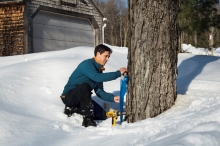You are here
Bullard Spotlight: Joshua Rapp on Sugar Maples in a Changing Climate

Our sugaring season began Feb. 1 this year, a full two weeks earlier than usual. Bullard Fellow Joshua Rapp taps Harvard Forest trees to inform several inter-related studies of sugar maple.
The first study, Rapp began in 2011, when he was a Harvard Forest postdoctoral fellow examining the relationship between sugar maples' stored nonstructural carbohydrates (sugars and starches) and seed production. His early results show that in mast years, when sugar maples produce an exceptionally high number of seeds, the amount of sugar in their sap drops the following spring.
Rapp's second project expands upon his sap collecting and seeks to understand how maple syrup production may be affected by climate change. With colleagues from several other universities, he is studying how sap quality – its sugar content and secondary chemistry – is related to climate, across a latitudinal gradient that spans the sugar maple's range from southern Virginia to Quebec. The project is funded by the Northeast Climate Science Center.
Rapp's third project looks at another aspect of the climate problem. He is working with HF senior scientist Jonathan Thompson and HF post-doc Matthew Duveneck to forecast where economically viable maple tapping areas will be found in the future under likely scenarios of climate and landscape change (using the Landis-II forest landscape model).
Rapp says the Harvard Forest is an ideal location for these projects due to its study subjects, tools, and expertise: "For the field work, the trees I study are right along Prospect Hill Road near Shaler Hall, so I can keep tabs on them throughout the year. 'Bucky' the portable canopy lift makes for easy access to tree canopies to study tree reproductive processes. The expertise in forest landscape modeling of Thompson is also key; collaborating with them is vital for my efforts to forecast where maple taps will be in the future."
- Browse Rapp's website and research photo gallery.
- Read news stories in the Chicago Tribune, Worcester Telegram, Chicago Tonight, New York Times, and Mass. 22 News
- Learn more about ACERnet, a consortium of scientists studying climate impacts on sugar maple and maple syrup production
- Learn more about the Harvard Forest Bullard Fellowship program
(Photo by Jenny Hobson)

